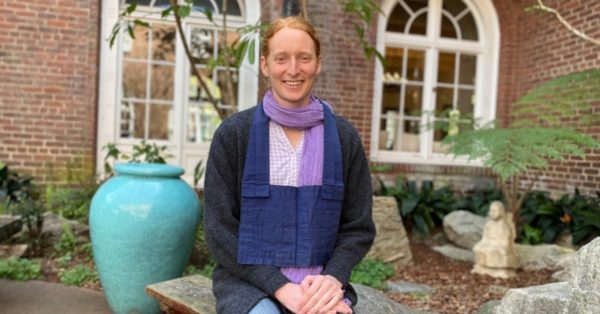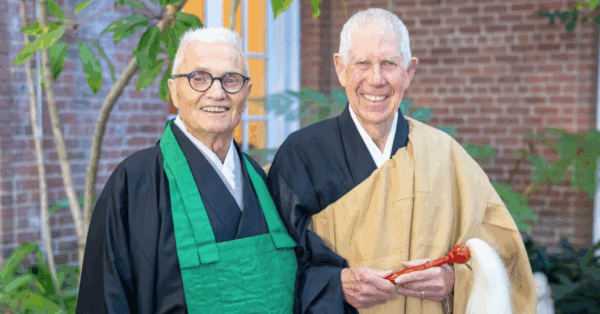
Photo by Tova Green.
By Tova Green
Kei Van Arnam has been the City Center Ino since January 1, 2023. She calls the Ino and the crew working with her “the bringers of happiness to the temple,” a phrase used by Eihei Dogen in “Pure Standards for the Temple Administrators,” written in 1246. The Ino is often referred to as the head of the mediation hall. “There’s some truth to that,” according to Kei. “What I find is a more accurate description of what I’m doing is coordinating and facilitating ceremonies. I’ve had a deep love of Soto Zen ritual. The chance to be so intimate with ceremony and to bring others into that has been very meaningful. This includes training people, not just in the technical details of sounding the various instruments—bells, drums, etc.—and chanting, but to try to inspire them with the importance of ceremony and the incredible practice opportunity it is to do that.” She feels that training people to participate in ceremonies is bringing them into the particular Soto Zen expression of the spiritual life.
In addition, Kei loves getting to interact more with community members who attend meditation, ceremonies, and events: “I’m often the first person they meet when they enter the door. I get to see how meaningful it is for people to partake in these offerings, whether it’s their first one-day sitting or a memorial service they’ve requested for a loved one, or their first time chanting.” These thoughts align with another description of the Ino’s role by Dogen: The Ino is “just like the rudder of a boat crossing the great river or a long rainy spell after a great drought.” Kei sees her role as important in this moment, when we’re bringing back and re-enlivening City Center’s public offerings and classes as an urban temple. She enjoys the relationship aspect of the Ino role, whether it’s with residents on the doanryo (those who play the ceremonial instruments, lead chanting, and take care of altars), or someone attending a Dharma talk.
Much as Kei enjoys the position of Ino, the role is a busy one at times of the year when there are many ceremonies. It can be a challenge to “stay steady in the midst of a lot of activity.” Also, public speaking doesn’t come easily for Kei: ”It’s a rich practice to express what needs to be expressed; for example, making announcements at morning work circles so that those who are newer to the temple are introduced to some of the ceremonial forms.”
Being at Tassajara for a year helped prepare Kei for the position of Ino. She was fukuten (assistant to the head cook) for one practice period and a summer. This crew head position was her first experience of being in a supervisory relationship with others, noticing people’s strengths and encouraging them to grow. She learned how and when to challenge people. Then she was Head Doan (assistant to the Ino) for a practice period. “This was pure joy! We had a great crew. We got along well and had so much fun. By rehearsing ceremonies over and over I got the liturgy in my bones.”
Last Fall, Kei was planning to return to City Center. “I was at a point in my practice where I was trying to see how to express my practice more.” She decided to enroll in the yearlong Sati Center Buddhist Chaplaincy Training led by Gil Fronsdal, Paul Haller, and Jennifer Block and began the program in Fall 2022. She thinks that being the Ino fits well with training as a chaplain. Both have to do with recognizing the important role of ritual in people’s lives, marking moments in the year or in the life cycle. Kei sees chaplaincy training as a way of being present for others who are experiencing difficulties, and doing that from a solid spiritual ground of presence, openness, and compassion. As part of her training, Kei volunteers with the San Francisco Night Ministry. She goes on night walks and encounters whoever happens to be out on the street during the night. She has conversations with them, listens, provides human connection and spiritual and emotional support.
“It’s been incredible. Just saying hello to somebody standing on the sidewalk. Initially some people are caught in their own world—like any of us. As we talk, over the course of the conversation I can see them relaxing a bit, smiling. We remind each other of our humanity and say goodbye. Some people live on the streets, some are working, others are on their way home, coming back from somewhere.”
Kei grew up in Southeastern Connecticut, “both in the woods and on the ocean. I was always in the woods finding creatures and exploring, or in the ocean swimming or boating. Both of those places have been home for me.” She first encountered Zen at Hamilton College in upstate New York, where there was a sitting group led by a Zen practitioner. She went to Syracuse Zen Center, a Rinzai temple, a few times. She remembers taking her seat in the zendo and catching a glimpse of the teacher’s face. “She was so still. Her eyes were wide open. She was so peaceful.”
Later Kei lived in Cambridge, Massachusetts, and practiced at the Cambridge Zen Center, an affiliate of the Kwan Um school of Zen. She had heard of Ryūmon Hilda Baldoquín through their book, Dharma, Color and Culture, New Voices in Western Buddhism, and when Kei moved to Western Massachusetts she began showing up at Two Streams Zen, the temple Ryūmon had co-founded. “When I met Ryūmon I was meeting someone who saw all of me—my insecurities and suffering—and who also saw me as complete and whole. I felt like I could be completely honest and completely supported.” Ryūmon is Kei’s root teacher. Kei received lay ordination from Ryūmon and the name Keishun/Joyous Spring. She continues to train with Ryūmon by Zoom.
Kei came to San Francisco Zen Center about four years ago. “I was seeking religious formation, to have spiritual practice as the foundation of my life. SFZC was a place where I could do that, be a full time resident and train in Zen practice. Life was pretty good for me before Zen Center and yet I felt that something was missing. There was a hollowness in me.” Kei practiced at City Center for five months, then at Tassajara until the pandemic hit. She worked on the farm at Green Gulch for a summer. She was invited back to City Center during the pandemic and worked in the kitchen. When Tassajara opened up for a practice period she went back there and stayed a year.
Kei is grateful for all the teachers and Dharma friends she has had throughout her life. “I did not get here alone; I could not be here without them.”











